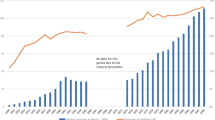Abstract
This paper examines the changing status of women faculty through an analysis of statistics on China’s universities from 1994 to 2004. This paper first presents the trend of a drastic increase in women faculty members in recent years. Further details on the academic ranks of women faculty, their age and highest degrees obtained are also presented. A comparison of female representation in faculty ranks is made between China and a few selected countries. Lastly, this paper attempts to account for the low percentage of female professors in higher education. Recommendations for the professional development for women faculty are made in the end.
摘要
本文通过对1994年至2004年中国高校女教师队伍发展的数据分析, 指出了近年来女教师队伍急剧扩大的趋势, 分析了女教师的职称、 年龄和学位结构, 并就女教授的比例在中国和其他国家之间进行了比较, 解释了女教授在高校中比例低的原因, 进而提出了高校女教师发展的现实策略。
Similar content being viewed by others
References
Altabach P G (1996). The International Academic Profession: Portraits of Fourteen Countries. San Francisco: Jossey-Abss Inc., Publishers
Caplan P J (1994). Lifting a Ton of Feathers: A Women’s Guide to Surviving in the Academic World. Toronto: University of Toronto Press
Development of Planning and Construction of State Education Commission of PRC (1995). Educational Statistics Yearbook of China 1994. Beijing: People’s Education Press (in Chinese)
Development of Planning and Construction of Ministry of Education PRC (2000). Educational Statistics Yearbook of China 1999. Beijing: People’s Education Press (in Chinese)
Development of Planning and Construction of Ministry of Education PRC (2001). Educational Statistics Yearbook of China 2000. Beijing: People’s Education Press (in Chinese)
Development of Planning and Construction of Ministry of Education PRC (2002). Educational Statistics Yearbook of China 2001. Beijing: People’s Education Press (in Chinese)
Development of Planning and Construction of Ministry of Education PRC (2003). Educational Statistics Yearbook of China 2001. Beijing: People’s Education Press (in Chinese)
Development of Planning and Construction of Ministry of Education PRC (2004). Educational Statistics Yearbook of China 2003. Beijing: People’s Education Press (in Chinese)
Development of Planning and Construction of Ministry of Education PRC (2005). Educational Statistics Yearbook of China 2004. Beijing: People’s Education Press (in Chinese)
Dobson I R (2006). Broken down by sex and age: Australian university staffing patterns 1994–2003. Higher Education Management and Policy, 18(1): 67
Huang H F (1996). On essential of female faculty’s multi-role conflicts in China. Shanghai Research in Higher Education, (5): 39–40 (in Chinese)
Li Y H (2002). An investigation into the present situation of intellectual omen’s social gender consciousness in universities and colleges and its countermeasures and reflections. Journal of China Women’s University, (2): 33–36 (in Chinese)
Liu X, Liu H Y (2002). Mental confusion and adjustment for the middle-aged female college teachers. Journal of Shandong University of Technology (Philosophy and Social Sciences Edition), (4): 104–107 (in Chinese)
Pool M, Bomholt L, Summers F (1997). An international study of the gendered nature of academic work: Some cross-cultural explorations. Higher Education, 373–396
Qu W Y (1995). Role conflicts of career women in current China. Academic Exchange, (4): 123–126 (in Chinese)
Sutherland M B (1994). Two steps forward and one step back: Women in higher education in the United Kingdom. In: Stiver L S, Malik L, Harris D, eds. The Gap in Higher Education. World Yearbook of Education. London: Kogan Page
Wei G Y (1995). Traditional culture and the role-taking of China’s contemporary educated women. Journal of Peking University (Philosophy and Social Sciences Edition), (3): 79–82 (in Chinese)
Wei G Y (2002). China’s contemporary educated women: Their role-taking versus Confucianism. Competent Authorities, (2): 15–19 (in Chinese)
White K, Bagilhole B (2005). Benign burden: Gender and senior management in the UK and Australia, Fourth European Conference on Gender Equality in Higher Education. Book of Abstracts, Oxford Brookes University
Wu Y W, Yao A Y (2002). Female college teachers’ role conflicts and social support. Journal of Maomin College, (2): 38–40 (in Chinese)
Zhang J Q (1997a). On the current situation of female faculty status in China. Tsinghua Journal of Education, (4): 54–61 (in Chinese)
Zhang J Q (1997b). Historical evolution of China’s female faculty team from year 1949. Jiansu Higher Education, (2): 72–75 (in Chinese)
Zhang J Q (2001). Women’s participation in higher education and the development and reform of higher education. Journal of China Women’s University, (4): 6–10 (in Chinese)
Zheng G Z (2004). An investigative report on the health conditions of the female professors in Shanghai’s colleges and universities. Collection of Women’s Studies, (5): 19–24 (in Chinese)
Author information
Authors and Affiliations
Corresponding author
Rights and permissions
About this article
Cite this article
Zhao, Y. An analysis on the status of female faculty in Chinese higher education. Front. Educ. China 2, 415–429 (2007). https://doi.org/10.1007/s11516-007-0034-7
Received:
Accepted:
Issue Date:
DOI: https://doi.org/10.1007/s11516-007-0034-7



